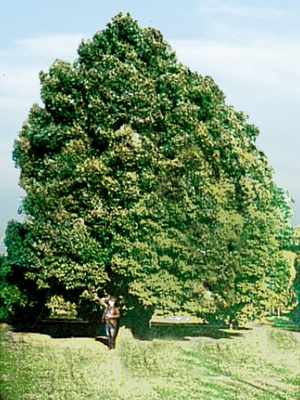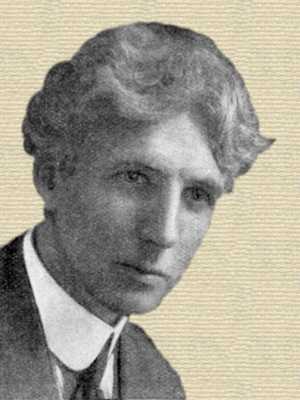 (source)
(source)
|
Robert Kennedy Duncan
(1 Nov 1868 - 18 Feb 1914)
Canadian industrial chemist, teacher and populariser of science who was a preeminent writer interpreting science and advocated partnering scientific research and industry to create new and better consumer products. As director of the Mellon Institute of Industrial Research he brought the learning of the university to the service of industry.
|
Camphor: An Industry Revolutionized
Chapter VII from Some Chemical Problems of Today (1911)
by Robert Kennedy Duncan
[p.128] THAT the processes of civilization are transforming the world with a velocity which is undergoing a continuous acceleration everybody, as a matter of intellectual acknowledgment, would be willing to admit, but the meteoric character of the velocity of this change is perhaps almost only adequately realized by those representatives of the great industrial corporations who are incidentally acting as the agents of Providence in its accomplishment. North, east, south, and west, pampas, savannahs, sierras, wind-swept hilltops and breathless jungles, all the imagined inaccessible places of romance and mystery, are yielding to the engineer, the manufacturer, and the industrial agent, and yielding, too, at such a rate that we are assured that even within the knowledge of our great-grandchildren this diverse and parti-colored world will have assumed the dull-gray tones of a universally static condition, a condition in which there will be probably, in so far as the conveniences and ideals of our civilization are concerned, but little essential difference between Canton, Ohio, and Canton, China. This coming gray monotony of life is desirable, [p.129] is regrettable, is inevitable, though we are sure that it, too, will yield ultimately and in its turn to vari-colored segregations of life and manners in new and beautiful forms and in a new and better world.
Meanwhile, with the rapid passing away of the older or different civilizations under the aggressive dominance of our own, there is passing away much, both of forms of knowledge and forms of life, that is of the highest potential value, and that never can be recalled.
There passes into some one little country of the immemorial East some one rather tawdry form of knowledge of our rather vulgar civilization, and forthwith there vanishes from that country some other form of knowledge, its own, the painful product of toilsome centuries of innumerable men—valuable to them and potentially valuable to us did we know enough to use it; it may be a dye, a perfume, a medicine, an edible dish, a thought, or a code of conduct, but it is gone absolutely and irrecoverably. As with forms of knowledge, so with forms of life; there is never a month passes but some species disappears which it has taken, not man but nature, not centuries but eons, to accomplish; and with all its place in the balance of life, with all its possibilities of usefulness, it is gone into eternal oblivion. Not merely the far future but the immediate present cries out for the conservation of such.
To speak plainly and emphatically and within the circle of interest of a materialistic age, I say that if there [p.130] are enormous pecuniary and material results to be obtained through forcing the products of our civilization upon foreign peoples (and about this there can be literally no question), there is just as much material gain to be obtained through taking over from those foreign peoples their own disappearing forms of knowledge and forms of life and converting them to the needs and uses of our own civilization.
In order to precipitate this idea into a concrete form I might cite many instances of the profit of introducing Eastern knowledge into Western life, or Eastern life into Western knowledge, but it would take many a book to chronicle such. Let us rather take some one example—and as one happens to fall pat within contemporary interest, I shall take the subject of camphor. The pure, white, waxen camphor is to be found in every drug-store of every village of civilized man; every human being knows it when he sees it and smells it. It has been employed for countless generations as a fever specific, as an agent of purification, as an insecticide, etc.; and in later times in immense quantities in the manufacture of celluloid, in the preparation of high explosives, and in many other ways which have just arrived. But always it has come to us out of the East, from Japan and Formosa and China, but mostly from Formosa. There it exists locked up in the cells of a certain tree, the Laurus camphora, which, growing to a height of forty to sixty feet, covers with the shade of [p.131] its beautiful waxen leaves many thousands of acres of these semi-tropical lands. The traditional method of the extraction of camphor from the camphor-tree illustrates the art of manufacture under its most savage and primitive conditions (Fig. 31). A crude furnace temporarily constructed in the heart of the camphor forest, a rudely fashioned box to contain the chips and fragments of a neighboring camphor-tree, the hollow trunk of a tree to convey the steam and volatilized camphor from the chips, and an earthenware receptacle in which the camphor is condensed express the practice of the simple art of these people and their idea of the process of distillation by steam. Only trees at least fifty years old were felled for extraction, and only the wood of the tree was employed. How wasteful and mistaken was this traditional process will quickly be seen, but upon it, we must understand, for centuries we have been dependent.

The Russo-Japanese War, however, with its vivifying influence upon the people of Japan, as well as the coercion of the resulting vast public debt, turned the attention of the Japanese to this important product, and thereupon quickly followed certain results. First, the production of camphor was constituted a government monopoly, employing a bureau of its own, and fixing absolutely the selling prices on a continuously rising scale: for example, from 2.61 M. per kilo in the year 1903 up to 4 M. per kilo in 1907. They then proceeded to stimulate the camphor industry by increasing the [p.132] buying price from the producers. Next, as the camphor-trees in Formosa were practically exhausted in the settled districts, they evolved and set in motion a scheme of reforestation on a huge scale; in 1906, 346,000 trees were planted, in 1907, 1,300,000, in 1908, 4,830,000, and last year, 5,060,184 trees were placed in the ground. Finally, in order to supply the present market, very expensive expeditions were organized against the savages in the unsettled portions of Formosa, where camphor-trees abound. All this, one would think, would insure the validity of the monopoly desired, for the attempt seemed to be marked by all the intelligent foresight and the logical acumen that adorn successful monopolistic control. But the attempt to create a permanent monopoly in any natural product is a challenge to the world at large, and the failure of the Japanese government to establish it might fairly have been predicted. I shall use the “reasons why” for this failure not only for their general significance, but, as well, to exploit the interesting question of camphor itself.
First, it should be understood that camphor is a definite, individual chemical substance, and that while this fact would not interest the denizens of the forests of Formosa, it does most surely interest the denizens of chemical laboratories. For every individual substance has a story to tell to the chemist—a story just four chapters long.
Chapter I—How it may be isolated and analyzed; [p.133] Chapter II—What is its constitution, or how its atoms are related to one another in its molecule; Chapter III— How it may be synthesized—i.e., made in the laboratories out of other substances and by methods with which the plant or animal has nothing to do; and Chapter IV—How it may be made on the large scale—i.e., manufactured in such a fashion as to compete with the natural product. With the termination of the fourth chapter the covers are closed. But the decipherment of camphor has been one of the most difficult undertakings of chemical science. From 1785 on it has employed the skilled labors of generations of chemists. Its constitution was fought out through the claims of thirty warring formulas. In 1903, however, and, through the irony of fate, just when the Japanese had piously begun to raise the price of natural camphor, its constitution was established beyond cavil by the triumphant synthesis of the artificial product under the hands of Komppa. In view of the enormous difficulties of the subject, it is a reasonable statement that this making of a camphor in the laboratory identical with the camphor of the camphor-tree constitutes one of the greatest contemporary triumphs of mind over matter. Komppa’s synthesis was purely academic and wholly uncommercial, but it sealed the fate of the Japanese monopoly, as might readily have been divined by so astute a people. For no sooner was it accomplished than it excited the attention of a new army of [p.134] investigators—the industrial chemists. The patent offices of the world were soon crowded with alleged commercial syntheses of camphor, and of the favored processes companies were formed to exploit them, factories resulted, and in the incredibly short time of two years after its academic synthesis artificial camphor, every whit as good as the natural product, entered the markets of the world, to establish there, for those who have eyes to see, this cardinal truth that no body of men can reasonably expect to permanently monopolize the sale or growth of a natural product on an export basis.
And yet artificial camphor does not—and cannot— displace the natural product to an extent sufficient to ruin the camphor-growing industry. Its sole present and probable future function is to act as a permanent check to monopolization, to act as a balance-wheel to regulate prices within reasonable limits. The necessity of this somewhat undignified role for a chemical process lies within the nature of the process itself. Every artificial synthesis of a natural product must have some starting-point, some substance upon which to build (Fig. 32). If that substance exists in large quantities in coal-tar, or in petroleum, or other cheap and everywhere available material, the future looks dark for the natural product. If, on the contrary, the starting-point resides in some material from which it is difficult to extract it, or which is itself in great demand or on a rising market, the utility or validity of the process is correspondingly [p.136] limited. Now, all the processes of artificially manufacturing camphor start with pinene or some allied substance. But the great source of pinene is oil of turpentine, and to any one who knows the enormous extent to which oil of turpentine is adulterated, the increasing demands for it, its increasing scarcity, together with the widespread alarm over deforestation, it needs no demonstration that now and in the future it will be on a constantly rising market. While it is undoubtedly true that new and improved processes will cheapen the price of synthetic camphor, it must always start on the basis of a parent substance which is too expensive, with an expensive plant, expensive reagents, expensive labor, and with the consumption of considerable power. What still further limits the power of the synthetic industry lies in the parallel factors of valuable by-products of the camphor-tree in the form of oil of camphor, and in a remarkable discovery which has improved the camphor-growing industry; of these I shall speak again.

Meanwhile, the Japanese were confronted with another factor equally valid in preventing the monopolistic control of the world’s needs. There existed, belting the world, other lands having similar conditions of soil, rainfall, temperature, elevation, and cheap labor. Camphor could be grown elsewhere. In Ceylon preliminary experiments in the Botanical Gardens at Hakgala were so convincingly favorable to the planters that to-day thousands of acres of young camphor-trees lie here and there [p.137] everywhere over the island, growing luxuriantly, and established permanently as a source of the island’s wealth. Similar conditions are rapidly obtaining in Malaya. In Italy the Laurus camphora has been grown as a shade tree for a hundred years, and, stimulated by this monopolistic menace, Giglioli has recently, in a comprehensive monograph, La Canfora Italiana, not only demonstrated that the camphor-tree has been and may be grown with the greatest ease in many sections of Italy, and that its camphor content is well up to the normal, but he has, through a masterly exposition of the conditions of its growing, placed within the hands of the Italian people of the landed class a new and profitable source of an assured income. Particularly interesting are the experiments of the Biological Station at Amani, German East Africa. There the director of the station has not only readily succeeded in growing camphor, but through a certain discovery he has made he bids fair to have revolutionized the industry. In our own country the plant has been grown for years as a shade tree in California, and so it has, as I am informed by numerous letters, in Texas and Florida. In these States, too, the Agricultural Department at Washington has for some years conducted successful experiments in camphor culture, and to such an extent that it feels warranted now in devoting time to the elaboration of an efficient still for the economic extraction of the camphor, by which any American camphor grower may extract his [p.138] own material. In Florida there is a flourishing camphor plantation at Satsuma. In the island of Jamaica the successful growth of the camphor-tree in the Hope Gardens at Kingston attracted the attention of a scion of one of the oldest families on the island, and five years ago, in a favored valley of his estate, he planted his experimental seeds. There, among three thousand acres of earthly paradise, and in a home so old that its cellars are loop-holed as a buccaneering stronghold, he earnestly watched over what the Caribbean breezes and sunshine evolved of the race of old Japan. After five years of watching and yearly planting, it was found that the trees, one, two, three, four, and five years old, hundreds of them, were all strong, straight-limbed, glossy-leaved, flourishing with all imaginable health and vigor. The camphor-tree would certainly grow in Jamaica. But would it yield camphor and oil of good quality and in proper amount? The growth of a plant in a land foreign to it by no means infers that it will reproduce its essential oils. It is known, for example, that down in Mexico they have for years been transplanting from India the Cannabis Indica, or Indian hemp, the material of a powerful drug; yet after two or three years of growing it turns out that this tree invariably reverts to Cannabis Americana, the extracted drug of which is wholly different, and the attempt, therefore, is at present a failure. In order to solve these questions, then, I brought back with me to the University of Kansas nearly a ton of material, which we worked up to the last ounce. We extracted the best of the camphor and the oil of camphor from the wood of the trunk, from the branches, the twigs, the green leaves, the dry leaves, and the dead leaves, and we obtained results which afforded us profound astonishment and great joy. We thought we had made a great discovery, and as a matter of fact we had, though, unfortunately for us, these results had just been anticipated by the work of Messrs. Campbell and Eaton in Malaya, and by the director of the Biological Station at Amani, East Africa. Since, however, our results absolutely confirm the work of these gentlemen, and since they are so important to the whole great camphor-growing industry, I give them here. As a matter of fact, and speaking in averages, our results analyzed out as follows:
| Wood | 0.61% of Crude Camphor |
| Twigs | 1.05% of Crude Camphor |
| Green Leaves | 2.37% of Crude Camphor; |
| Dried Leaves | 2.52% of Crude Camphor |
| Dead Leaves | 1.39% of Crude Camphor |
These results are extraordinarily high, owing partly to the fact that the material had undergone a considerable amount of drying in its long transport from Jamaica to Kansas, and partly, too, I believe, to the ideal conditions that obtain in Jamaica for the growth of essential oils. But it is the proportional amounts to which I draw attention. The wood of the camphor-tree [p.140] contains an insignificant fraction of the camphor contained in the green, dry, and dead leaves. This is to be correlated with the indisputable fact, as proved by Mr. Malcolm, of Jamaica, and others the world over, that the leaves can be harvested regularly without any injury to the tree. These two facts, taken together, place both the huge camphor monopoly of Japan and its synthetic manufacture in Germany and elsewhere in a position that would be laughable were it not rather pitiful. Both types of organization proceeded on the assumption that the centuries-old traditional method of extraction was the only one. In order to continue it, the Japanese felled only trees fifty years old and extracted the drug from the wood only, leaving the leaves out of consideration. In order to carry out this destructive work, they ran deadly electric wires through the forests to keep out the savages; they placed armed men with every camp of camphor-workers, and they paid these workers 90 cents a day for a native Formosan and $1.99 a day for a Japanese. The price of labor in Jamaica is a shilling a day. Now, as a matter of fact, in a five-year-old tree the mass of its leaves weighs 7.05 per cent. of the total bulk of the tree. The proper method, therefore, without destruction to the tree, is to regularly harvest its leaves for their excessively large camphor content; costly expeditions into savage interiors and the total destruction of mature trees are wholly unnecessary. Not only so, but through the investigations of Herr Lommel, [p.141] of the Biological Station at Amani, there appears an additional fact of extreme importance. As he says, “the great desideratum in camphor-growing is to lessen just as much as possible the expense of harvesting the leaves. To strip them off the tree or the branches by band is a time-consuming and more or less costly operation. If, instead of that, one can pick them up off the ground, the labor of harvesting will be minimized.” He has discovered that the naturally fallen leaves of the tree contain an exceptionally high per cent. of camphor, and his conclusions the labors of Giglioli and our own absolutely support.
To everybody, then, living in the semi-tropical belt and possessed of suitable conditions of soil, rainfall, and cheap labor, camphor-culture, through harvesting and extracting the fallen leaves, offers generous returns, and returns, too, that are not likely to be lessened through overproduction, for each year brings new and increasing demands for both camphor and oil of camphor through the advances of industrial chemistry in discovering and providing new uses for both.
Because of these facts, then, it is little wonder that, following the recent report of Schimmel & Co., the great German house engaged in the manufacture of essential oils, the efforts both for the monopolization of camphor and for its profitable synthetic production are hopelessly defeated. The moral, of course, is “Look before you leap,” into all the factors related to the production of [p.142] a natural product, remembering particularly that the biological and agricultural stations, that in ever-increasing numbers are dotting the surface both of civilized and uncivilized lands, have justified their existence many thousands of times over. Through their efforts a new industry has been added to the resources of many and diverse races of people.
To end as we began, if there are enormous pecuniary and material results to be obtained through forcing the products of our civilization on foreign peoples there is just as much material gain to be obtained through taking over from these foreign peoples their own disappearing forms of knowledge and forms of life and converting them to the needs and uses of our own civilization.
- Science Quotes by Robert Kennedy Duncan.
- 1 Nov - short biography, births, deaths and events on date of Duncan's birth.
- Harnessing Science to the Factory - article about the Mellon Institute of Industrial Research at the University of Pittsburgh, conceived by Robert Kennedy Duncan - from Popular Mechanics (1914.
- Bread - Chapter from Some Chemical Problems of Today (1911) by Robert Kennedy Duncan.






